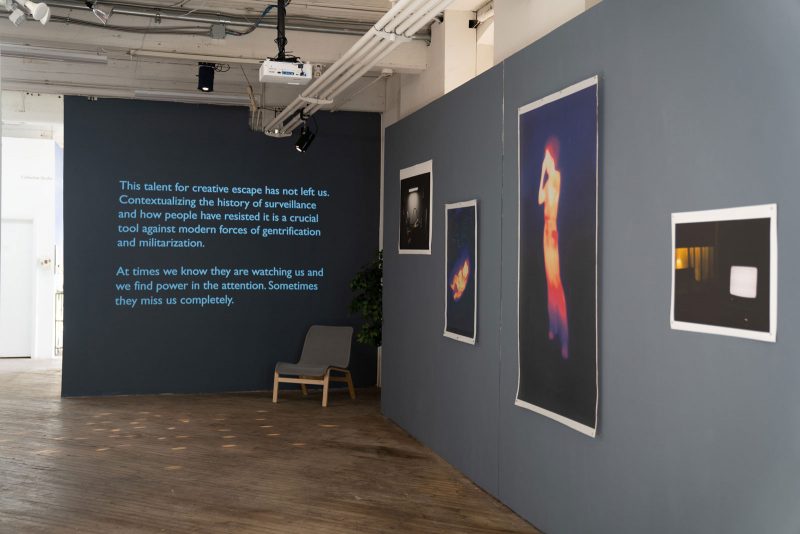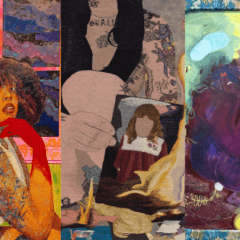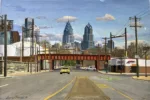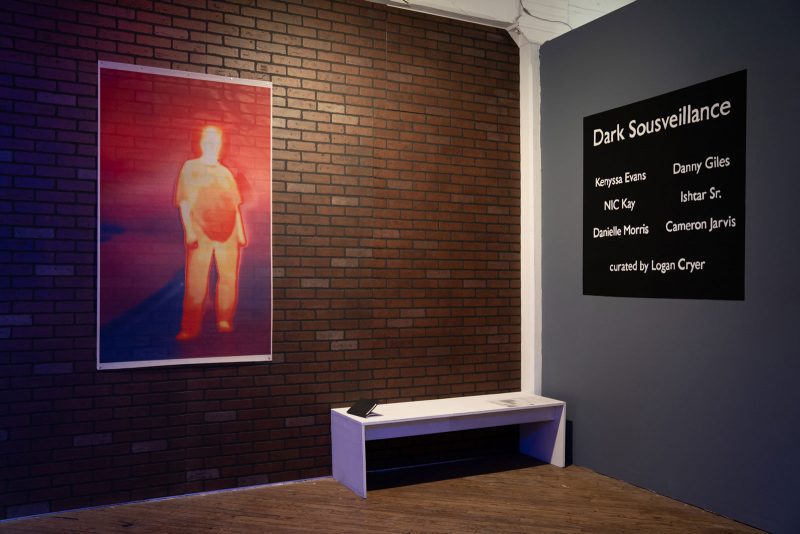
Art will have an uneasy relationship between its shape and its visage in 2022 as more artists eschew both the ambiguous self-indulgence of the abstract and the bloated tumescence of the appeal of settler capital. Art’s gotta mean something, at least it seems it will to the younger voices in this digital age of NFTs, among the grime of a Covid-decimated post-now, and under the backdrop and looming veil of continued oppression of the most marginalized and most vulnerable in the western hemisphere– queer Black people.
Vox Populi hosts the aesthetically tight event, Dark Sousveillance, curated by artist Logan Cryer, featuring artists who fall under the diasporic umbrella of Black, and predominantly queer. The show “… contemplates how Black people are responding to the tension between wanting to be seen by each other and wanting to hide from the violence of hyper-visibility. This desire to be known without being objectified is especially pronounced when entering most art spaces– spaces usually dominated by the white gaze.” Cryer is a non-binary artist, writer and curator whose pieces covering Philly area’s art community on Artblog are as eclectic and inclusive as Sousveillance. On display are intense microwave prints, sculptural and interactive pieces, film work, and explosive underground music. The works highlight the thematic vision presented by researcher Simone Browne when she coined the term “dark sousveillance”. From the Dark Sousveillance show description: “(Sousveillance describes) the phenomenon of enslaved Black people disappearing themselves from racialized surveillance by creatively subverting their own hypervisibility”
This idea of hypervisibility as both a blessing and a curse permeates the work of each artist. Perhaps most encompassing this theme is Kenyssa Evans’ “Make Yourself at Home” series of photographic prints on mesh screen. The shimmering, distorted images are liken to thermal radar often used in military surveillance and security equipment capturing heat signatures in distressed areas. The notion of hypervisibility is made apparent in each print’s anonymity (the Black body as targeted object, outline thermally) as the large scale reproductions shine a light on what’s missing: there is more than just a body there; there’s an entire subject, often criminalized for existing but existing nonetheless.
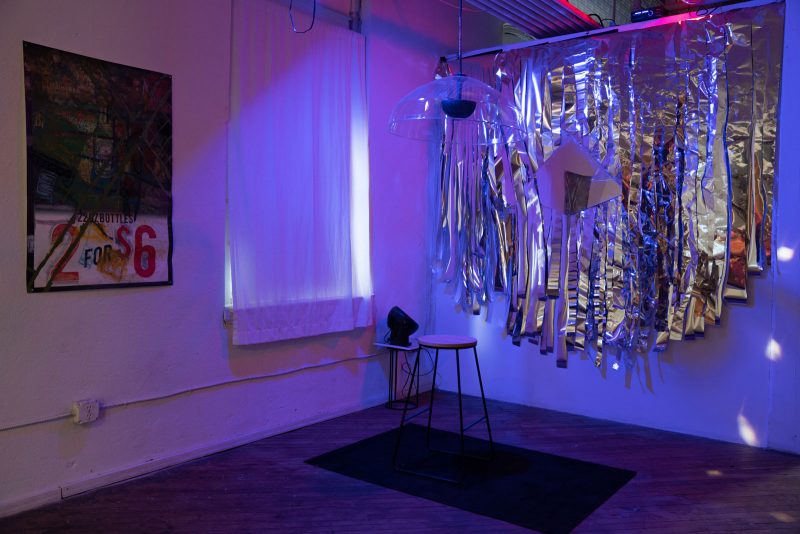
Ishtar Sr. takes us deeper into this matrix with “To Reside in the Belly of the Beast”, where a vanity mirror cascaded with tinsel and silver shines our reflection back to us. Accompanying the piece is the dense, multi-layered rap music of Ishtar and her various aliases– piercing paranoia-laced social commentary collaged with noisy, electronic funk as a dark contrast to the self-consuming “beauty center” constructed here. Yet, the mirror can symbolize a place of celebration for queer and trans people, a place of discovery and retreat. People marginalized by normative and oppressive standards of gender and sexuality often use the mirror as a means of escaping into other realms like portal children expressing themselves beyond drag and into new, final forms of being.
NIC Kay’s “keep at it” video deviates from these themes and offers a bit of visual levity. The subject– perhaps the artist themself– dances in various spots in housing projects, parks, on building steps, freely Black and queer in public spaces. The soundtrack is a stabbing, minimal ghettotech beat (ritualized Chicago and Detroit style house music at warp speeds) that belies the ebullient nature of the subject’s dance.
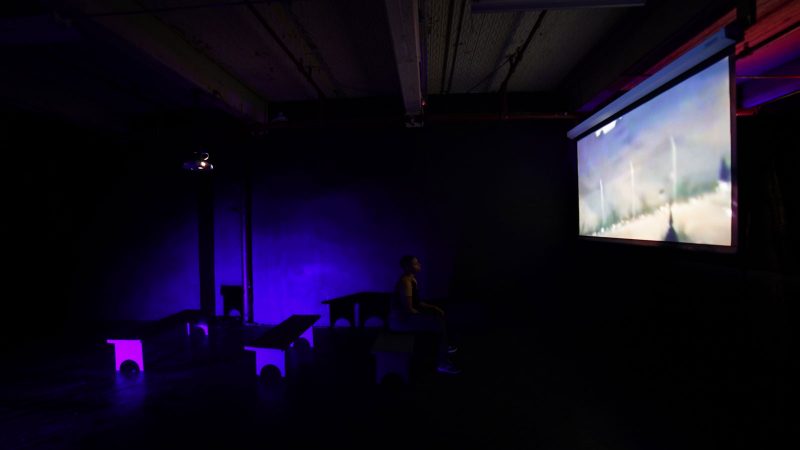
It’s in “Game” from Danny Giles, an 8 and a half minute video mini-opus, that we see not only the darkness shift but the framework for Sousveillance’s critique of perception. At first, a sludgy dirge of sound marks the presence of hooded figures moving in conspicuous sight of a possible drone or surveillance camera, and anticipatory tension builds as more figures announce themselves, moving in the darkness. The first spark of light shows, as a full scale bout of hood magic explodes into the street– the shrouded figures are shooting fireworks at each other in slow-motion. The play on perception is perhaps a little long, but the utter joy of the world unfurling as a magic tapestry for clearly marginalized youth is worth the patient, tension filled 8 minutes– it’s worth it to get your perception shattered, as this piece explores what it means to unearth joy in a world that tracks, hunts, and imprisons them.
Dark Sousveillance is art at the nexus point of now and the future. There’s a subtle moment happening encapsulated by recent exhibits like Low Visibility at Minnepolis’s Walker Art Center or 2019’s Designs for Different Futures exhibit which showed at the Philadelphia Museum of Art— work examining the idea of what is seen and how, particularly in a clash with technology, government and spirit. What separates Sousveillance is its ideas that in a watcher-state, that Orwellian oppression drastically affects Black and queer folks and that those experiences are unique even as the algorithm slowly closes in on us all. While there aren’t a lot of solutions and practical applications offered in Dark Sousveillance, there is expression, there is a knowledge being dropped, and through that there is hope.
“Dark Sousveillance” is on view through Sunday, Jan. 16 2022, at Vox Populi Gallery. Gallery hours are Fri- Sun, 12-6 PM and by appointment. Schedule your visit here!
Reviews, podcasts, and more by ‘Dark Sousveillance’ curator Logan Cryer are available on Artblog here. See also, Alex Smith’s 2019 review of the PMA’s “Designs for Different Futures” exhibition, mentioned above.
